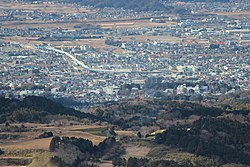Kannami, Shizuoka
|
Kannami 函南町 |
|||
|---|---|---|---|
| Town | |||

A view of downtown Kannami
|
|||
|
|||
 Location of Kannami in Shizuoka Prefecture |
|||
| Coordinates: 35°5′20.2″N 138°57′12.2″E / 35.088944°N 138.953389°ECoordinates: 35°5′20.2″N 138°57′12.2″E / 35.088944°N 138.953389°E | |||
| Country | Japan | ||
| Region |
Chūbu Tōkai |
||
| Prefecture | Shizuoka Prefecture | ||
| District | Tagata | ||
| Area | |||
| • Total | 65.16 km2 (25.16 sq mi) | ||
| Population (September 1, 2015) | |||
| • Total | 38,120 | ||
| • Density | 585/km2 (1,520/sq mi) | ||
| Time zone | Japan Standard Time (UTC+9) | ||
| - Tree | Stewartia | ||
| - Flower | Sakura | ||
| Phone number | 055-979-8105 | ||
| Address | 717-13, Hirai, Kannnami-chō, Tagata-gun, Shizuoka-ken 419-0192 | ||
| Website | Official website | ||
Kannami (函南町 Kannami-chō?) is a town located in Tagata District, Shizuoka Prefecture, Japan. As of September 2015, the town had an estimated population of 38,120 and a population density of 585 persons per km². The total area was 65.16 square kilometres (25.16 sq mi).
Kannami is located in an inland area in far eastern Shizuoka Prefecture, in the foothills of the Hakone Mountains. The Kano River passes through the town. Kannami has a temperate maritime climate with hot, humid summers and mild, cool winters.
During the Edo period, all of Izu Province was tenryō territory under direct control of the Tokugawa shogunate. During the cadastral reform of the early Meiji period in 1889, the village of Kannami was created within Tagata District, Shizuoka Prefecture. On April 1, 1962, it was elevated to town status.
The economy of Kannami is primarily based on agriculture. Major products include strawberries, cucumbers and dairy products. The town is also a bedroom community for neighboring Mishima.
Kannami has five elementary schools, two middle schools and two high schools.
...
Wikipedia



